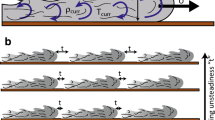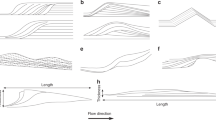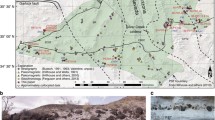Abstract
Although erosion during high-energy passage of a pyroclastic density current (PDC) causes great damage, analyses of the effects of such erosion are sparse in scientific literature compared to observations and interpretations of depositional processes. In this paper, we review observations of surfaces where PDCs have eroded sets of grooves that provide information on the erosion process. We postulate that in some cases, the grooves were carved by streamwise vortices in the boundary layer of the PDC and review possible fluid dynamic instabilities that can give rise to such vortices. For the prominent grooves at Volcán Bárcena, Mexico, we propose that a fluid dynamic instability, which we dub the “groovy instability,” occurred and caused formation of erosive counter-rotating vortices. This instability occurs when the particle concentration boundary layer thickness, δc, is larger than the velocity (shear) boundary layer thickness, δu, i.e., L=δc /δu>1. In subaqueous turbidity currents, these vortices have a typical wavelength of ~25*δc. If this relation is applied to the grooves formed on Volcán Bárcena, the inferred particle concentration boundary layer is estimated to have been <1 m thick. We postulate that a transition between erosion of grooves and deposition of dunes at Volcán Bárcena occurred when hydraulically supercritical flow on the upper flanks changed to subcritical flow about halfway down the mountain. We call attention to boundary layer dynamics in erosive pyroclastic density currents at a dimension that is difficult to scale quantitatively in laboratory experiments and is usually not resolved computationally and to the need for incorporating such dynamics into models of PDC dynamics.












Similar content being viewed by others
Data Availability
Not applicable
Change history
10 April 2021
A Correction to this paper has been published: https://doi.org/10.1007/s00445-021-01456-1
References
Ancey C (2004) Powder snow avalanches: approximation as non-Boussinesq clouds with a Richardson number-dependent entertainment function. J Geophys Res 109:F01005
Bernard J, Kelfoun K, LePennec JL, Vargas SV (2014) Pyroclastic flow erosion and bulking processes: comparing field-based vs. modeling results at Tungurahua volcano. Ecuador Bull Volcanol 76:858
Brand BD, Mackaman-Lofland C, Pollock NM, Bendana S, Dawson B, Wichgers P (2014) Dynamics of pyroclastic density currents: conditions that promote substrate erosion and self-channelization—Mount St. Helens, Washington (USA). J Volcanol Geotherm Res 276:189–214
Branney MJ, Kokelaar P (2002) Pyroclastic density currents and the sedimentation of ignimbrites. Geol Soc Memoir 27, London, Coleman
Breard ECP, Lube G (2017) Inside pyroclastic density currents-uncovering the enigmatic flow structure and transport behavior in large-scale experiments. Earth Planet Sci Lett 458:22–36
Breard ECP, Lube G, Jones JR, Dufek J, Cronin SJ, Valentine GA, Moebis A (2016) Coupling of turbulent and non-turbulent flow regimes within pyroclastic density currents. Nat Geosci 9:767–771
Brosch E, Lube G (2020) Spatiotemporal sediment transport and deposition processes in experimental dilute pyroclastic density currents. J Volcanol Geotherm Res 401:106946
Burgisser A, Bergantz GW (2002) Reconciling pyroclastic flow and surge: the multiphase physics of pyroclastic density currents. Earth Planet Sci Lett 202:405–418
Bursik MI, Woods AW (1996) The dynamics and thermodynamics of large ash flows. Bull Volcanol 58:175–193
Calder ES, Sparks RSJ, Gardeweg MC (2000) Erosion, transport and segregation of pumice and lithic clasts in pyroclastic flows inferred from ignimbrite at Lascar Volcano, Chile. J Volcanol Geotherm Res 104:201–235
Carrivick JL, Smith MW, Quincey DJ (2016) Structure from motion in the geosciences. Wiley 197 pp
Cashman KV, Soule SA, Mackey BH, Deligne NI, Deardorff ND, Dietterich HR (2013) How lava flows: new insights from applications of lidar technologies to lava flow studies. Geosphere 9:1664–1680
Cantero MI, Balachandar S, Garcia MH (2007) High-resolution simulations of cylindrical density currents. J Fluid Mech 590:437–469
Coleman JM (1981) Erosional grooves on continental shelf edge, Mississippi delta region. Geo-Marine Lett 1:11–15
Dellino P, Mele D, Sulpizio R, La Volpe L, Braia G (2008) A method for the calculation of the impact parameters of dilute pyroclastic density currents based on deposit particle characteristics. J Geophys Res 113:1–21
de’ Michieli Vitturi M, Esposti Ongaro T, Lari G, Aravena A (2019) IMEX_SfloW2D 1.0: a depth-averaged numerical flow model for pyroclastic avalanches. Geosci. Model Dev 12:581–595
Doronzo DM, Marti J, Dellino P, Giordano G, Sulpizio R (2016) Dust storms, volcanic ash hurricanes, and turbidity currents: physical similarities and differences with emphasis on flow temperature. Arab J Geosci 9:9
Douillet GA, Pacheco DA, Kueppers U, Letort J, Tsang-Hin-Sun E, Bustillos J, Hall M, Ramon P, Dingwell DB (2013a) Dune bedforms produced by dilute pyroclastic density currents from the August 2006 eruption of Tungurahua volcano. Ecuador Bull Volcanol 75:762–781
Douillet GA, Tsang-Hin-Sun E, Kueppers U, Letort J, Pacheco DA, Gold Stein F, Aulock FV, Lavallee Y, Hanson JB, Gustillos J, Robin C, Ramon P, Hall M, Dingwell DB (2013b) Sedimentology and geomorphology of the deposits from the August 2006 pyroclastic density currents at Tungurahua volcano. Ecuador Bull Volcanol 75:765–785
Dufek J (2016) The fluid mechanics of pyroclastic density currents. Annu Rev Fluid Mech 48:459–485
Dufek J, Ongaro TE, Roche O (2015) Pyroclastic density currents: processes and models. In: Sigurdsson H, Houghton B, McNutt SR, Rymer H, Stix J (eds) The encyclopedia of volcanoes. Elsevier, London, pp 617–629
Eglit ME, Kulibaba VS, Naaim M (2007) Impact of a snow avalanche against an obstacle. Formation of shock waves. Cold Reg Sci Technol 50:86–96
Fauria KE, Manga M, Chamberlain M (2016) Effect of particle entrainment on the runout of pyroclastic density currents. J Geophys Res 121:6445–6461
Fisher RV (1977) Erosion by volcanic base-surge density currents: U-shaped channels. Geol Soc Am Bull 88:1287–1297
Fisher RV, Glicken HX, Hoblitt RP (1987) May 18, 1980, Mount St. Helens deposits in South Coldwater Creek, Washington. J Geophys Res 92(B10):10,267–10,283
Freundt A, Schmincke H-U (1985) Lithic-enriched segregation bodies in pyroclastic flow deposits of Laacher See Volcano (East Eifel, Germany). J Volcanol Geotherm Res 25:193–224
Gioia G, Chakraborty P, Gary SF, Zamalloa CZ, Keane RD (2011) Residence time of buoyant objects in drowning machines. Proc Nat Acad Sciences 108(16):6361–6363
Grant KT, Estes GB (2009) Darwin in Galapagos: footsteps to a New World. Princeton Univ. Press, Princeton, p 376
Hakonardottir KM (2004) The interaction between snow avalanches and dams. In: Mathematics. Univ. of Bristol, p 142 pp.
Hall B, Meiburg E, Kneller B (2008) Channel formation by turbidity currents: Navier-Stokes-based linear stability analysis. J Fluid Mech 615:185–210
Härtel C, Carlsson F, Thunblom M (2000b) Analysis and direct numerical simulation of the flow at a gravity-current head. Part 2. The lobe-and-cleft instability. J Fluid Mech 418:213–229
Härtel C, Meiburg E, Necker F (2000a) Analysis and direct numerical simulation of the flow at a gravity-current head. Part 1. Flow topology and front speed for slip and no-slip boundaries. J Fluid Mech 418:189–212
Iverson RM, Ouyang C (2015) Entrainment of bed material by Earth-surface mass flows: review and reformulation of depth-integrated theory. Rev Geophys 53:27–58
Karcz I (1967) Harrow marks, current-aligned sedimentary structures. J Geol 75(1):113–121
Kelfoun K (2017) A two-layer depth-averaged model for both the dilute and the concentrated parts of pyroclastic currents. J Geophys Res Solid Earth 122:4293–4311
Kieffer SW (1981) Fluid dynamics of the May 18 blast at Mount St. Helens. U.S. Geol Surv Prof Pap 1250:379–400
Kieffer SW (1985) The 1983 hydraulic jump in crystal rapid: implications for river-running and geomorphic evolution in the Grand Canyon. J Geol 93(4):385–406
Kieffer SW, Sturtevant B (1988) Erosional grooves formed during the lateral blast at Mount-St-Helens, May 18, 1980. J Geophys Res Solid Earth 93(B12):14793–14816
Lacroix A (1904) La Montagne Pelee et ses Eruptions. Masson et Cie, Paris, p 662
Lastras G, Canals M, Urgeles R, Amblas D, Ivanov M, Droz L, Dennielou B, Fabres J, Schoolmeester T, Akhmetzhanov A, Orange D, Garcia-Garcia A (2007) A walk down the Cap de Creus canyon, Northwestern Mediterranean Sea: recent processes inferred from morphology and sediment bedforms. Mar Geol 246(2-4):176–192
Le L, Pitman EB (2009) A model for granular flows over an erodible surface. SIAM J App Math 70(5):1407–1427
Levine AH, Kieffer SW (1991) Hydraulics of the August 7, 1980, pyroclastic flow at Mount St. Helens, Washington. Geology 19:1121–1124
Lube G, Breard ECP, Cronin SJ, Procter JN, Brenna M, Moebis A, Pardo N, Stewart RB, Jolly A, Fournier (2014) Dynamics of surges generated by hydrothermal blasts during the 6 August 2012 Te Maari eruption, Mt. Tongariro, New Zealand. J Volcanol Geotherm Res 286:348–366
Lube G, Breard ECP, Esposti-Ongaro T, Dufek J, Brand B (2020) Multiphase flow behavior and hazard prediction of pyroclastic density currents. Nature Rev Earth Environ 1:348–365
Macias JL, Espindola JM, Bursik MI, Sheridan MF (1998) Development of lithic-breccias in the 1982 pyroclastic flow deposits of El Chichon Volcano, Mexico. J Volcanol Geotherm Res 83:173–196
Mattson PH, Alvarez W (1973) Base surge deposits in Pleistocene volcanic ash near Rome. Trans Am Geophys Union 54(4):1–20
Moore JG (1967) Base surge in recent volcanic eruptions. Bull Volcanol 30(1):337–363
Moore JG, Nakamura K, Alcaraz A (1966) The 1965 eruption of Taal Volcano. Science 151:955–960
Moore JG, Sisson TW (1981) Deposits and effects of the May 18 pyroclastic surge. In: Lipman PW, Mullineaux DR (eds) The 1980 Eruptions of Mount St. Helens. Washington. U.S. Gov. Printing Office, Washington, D.C., pp 421–438
Nasr-Azadani MM, Meiburg E (2014) Turbidity currents interacting with three-dimensional seafloor topography. J Fluid Mech 75:409–443
Parker G, Fukushima Y, Pantin H (1986) Self-accelerating turbidity currents. J Fluid Mech 171:145–181
Pierson TC (1995) Flow characteristics of large eruption-triggered debris flows at snow-clad volcanoes: constraints for debris-flow models. J Volcanol Geotherm Res 66:283–294
Pierson TC, Janda RJ, Thouret JC, Borrero CA (1990) Perturbation and melting of snow and ice by the 13 November 1985 eruption of Nevado del Ruiz, Colombia, and consequent mobilization, flow and deposition of lahars. J Volcanol Geotherm Res 41:17–66
Pittaluga MB, Imran J (2014) A simple model for vertical profiles of velocity and suspended sediment concentration in straight and curved submarine channels. J Geophys Res F Earth Surf 119:483–503
Pollock NM, Brand BD, Rowley PJ, Sarocchi D, Sulpizio R (2019) Inferring pyroclastic density current flow conditions using syn-depositional sedimentary structures. Bull Volcanol 81:16
Puig P, Palanques A, Orange DL, Lastras G, Canals M (2008) Dense shelf water cascades and sedimentary groove formation in the Cap de Creus Canyon, northwestern Mediterranean Sea. Cont Shelf Res 28:2017–2030
Rastello M, Hopfinger EJ (2004) Sediment-entraining suspension clouds: a model of powder-snow avalanches. J Fluid Mech 509:181–206
Richards AF (1956) Geology of the Islas Revillagigedo, Mexico. 1, Birth and development of Volcán Bárcena, Isla San Benedicto. Bull Volcanol 22:73–123
Robinson JE, Bacon CR, Major JJ, Wright HM, Vallance JW (2017) Surface morphology of caldera-forming eruption deposits revealed by lidar mapping of Crater Lake National Park, Oregon—implications for deposition and surface modification. J Volcanol Geotherm Res 342:61–78
Roche O (2015) Nature and velocity of pyroclastic density currents inferred from models of entrainment of substrate lithic clasts. Earth Planet Sci Lett 418:115–125
Saucedo R, Macias JL, Bursik MI, Mora JC, Gavilanes JC, Cortes A (2002) Emplacement of pyroclastic flows during the 1990-1999 eruption of Volcan de Colima, Mexico. J Volcanol Geotherm Res 117:129–153
Scarpati C, Perrotta A (2012) Erosional characteristics and behavior of large pyroclastic density currents. Geology 40(11):1035–1038
Sequeiros OE (2012) Estimating turbidity current conditions from channel morphology: A Froude number approach. J Geophys Res 117:C040003 19 pages
Shimizu HA, Koyaguchi T, Suzuki YJ (2019) The run-out distance of large-scale pyroclastic density currents: a two-layer depth-averaged model. Jour. Volcanol Geotherm Res 381:168–184
Simpson JE (1997) Gravity currents: In the Environment and the Laboratory. Cambridge University Press, Cambridge
Sparks RSJ, Barclay J, Calder ES, Herd RA, Komorowski JC, Luckett R, Norton GE, Ritchie LJ, Voight B, Woods AW (2002) Generation of a debris avalanche and violent pyroclastic density current on 26 December (Boxing Day) 1997 at Soufrière Hills Volcano, Montserrat. In: T.H. D, Kokelaar BP (eds) The Eruption of Soufrière Hills Volcano, Montserrat, from 1995 to 1999. Geol Soc London Mem, London 21, pp 409-434
Sparks RSJ, Gardeweg MC, Calder ES, Matthews SJ (1997) Erosion by pyroclastic flows on Lascar volcano, Chile. Bull Volcanol 58:557–565
Sulpizio R, Dellino P, Doronzo DM, Sarocchi D (2014) Pyroclastic density currents: state of the art and perspectives. J Volcanol Geotherm Res 283:36–65
Swearingen JD, Blackwelder RF (1987) The growth and breakdown of streamwise vortices in the presence of a wall. J Fluid Mech 182:255–290
Tani I (1962) Production of longitudinal vortices in boundary layer along a concave wall. J Geophys Res 67(8):3075–3080
Thouret J-C (1990) Effects of the November 13, 1985 eruption on the snow pack and ice cap of Nevado del Ruiz volcano, Colombia. J Volcanol Geotherm Res 41:177–201
Timmermans ME, Lister JR, Huppert HE (2001) Compressible particle-driven gravity currents. J Fluid Mech 445:305–325
Valentine GA (1987) Stratified flow in pyroclastic surges. Bull Volcanol 49(4):616–630
Wadey PD (1991) On the nonlinear development of Gortler vortices in a compressible boundary layer. Stud Appl Matt 85:317–341
Westoby MJ, Brasington J, Glasser NF, Hambrey MJ, Reynolds JM (2012) 'Structure-from motion- photogrammetry: a low-cost, effective tool for geoscience applications. Geomorphology 179:300–314
Wilkinson C, Harbor DJ, Helgans E, Keuhner JP (2018) Plucking phenomena in nonuniform flow. Geosphere 14(5):2157–2170
Williams H (1952) Recent eruption on San Benedicto Island, Revilla Gigedo Group, Mexico. The Volcano Letter 517(7):1
Wohletz KH (1980) Explosive hydromagmatic volcanism. Ph.D. thesis. Arizona State University, Tempe, AZ
Woods AW, Bursik MI (1994) A laboratory study of ash flows. J Geophys Res 99(B3):4375–4394
Acknowledgments
We thank Jim Moore of the US Geological Survey for providing Richards’ original photos, Tom Pierson of the US Geological Survey for the Ruiz observations and photos, and Steve Sparks and Simon Powell of Bristol University for the images of Lascar and Soufrière Hills. We also thank Michael Ort for handling the reviews and for his own review comments, Frances van Wyk de Vries for the help with submission logistics, Andrew Harris for the encouragement to write this review article, and Roberto Sulpizio and an anonymous reviewer for the very detailed and helpful comments that greatly improved our analysis of the grooves on Volcán Bárcena.
Code availability
Not applicable
Funding
SWK gratefully acknowledges support from the Charles R. Walgreen, Jr. Foundation. EM gratefully acknowledges support from the National Science Foundation under grant CBET-1803380 and from the Army Research Office under grant W911NF-18-1-0379. JB acknowledges support from the Jack and Richard Threet chair in Sedimentary Geology. JMA thanks the Foster and Coco Stanback Innovation Fund for their support of this collaboration.
Author information
Authors and Affiliations
Contributions
SWK, EM, and JB were involved in all aspects of the work. JA was involved in the supercritical flow/hydraulic jump theory.
Corresponding author
Ethics declarations
Competing interests
The authors declare no competing interests.
Additional information
Editorial responsibility: M.H. Ort
Rights and permissions
About this article
Cite this article
Kieffer, S.W., Meiburg, E., Best, J. et al. The mysterious grooves of Volcán Bárcena: a review of the role of streamwise counter-rotating vortices during erosion by dilute pyroclastic density currents. Bull Volcanol 83, 26 (2021). https://doi.org/10.1007/s00445-021-01440-9
Received:
Accepted:
Published:
DOI: https://doi.org/10.1007/s00445-021-01440-9




